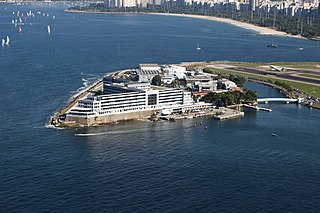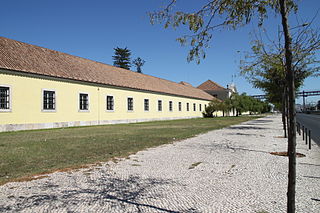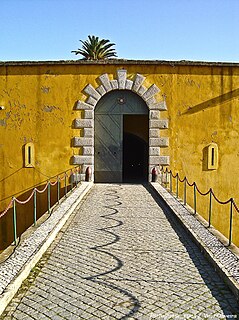
Seixal is a Portuguese city and municipality, located in the district of Setúbal, in the metropolitan area of Lisbon. Its population includes 184,269 inhabitants (2011), in an area of 93.58 square kilometres (36.13 sq mi) that includes six parishes. It is situated across the Tagus River estuary from Lisbon. Its seat is the city of Seixal, a centre of 31,600 inhabitants situated along the Rio Judeu.

The Brazilian Navy is the naval service branch of the Brazilian Armed Forces, responsible for conducting naval operations. The Brazilian Navy is the largest navy in South America and in Latin America, and the second largest navy in the Americas, after the United States Navy.

The Portuguese Navy is the naval branch of the Portuguese Armed Forces which, in cooperation and integrated with the other branches of the Portuguese military, is charged with the military defense of Portugal.

Belém is a freguesia and district of Lisbon, the capital of Portugal. Belém is located in western Lisbon, to the west of Ajuda and Alcântara and directly east of Lisbon's border with Oeiras. Belém is famous as a museum district, as the home of many of the most notable monuments of Lisbon and Portugal alike, such as the Belém Tower, the Jerónimos Monastery, the Padrão dos Descobrimentos, and Belém Palace. The population in 2011 was 16,528.
The Naval School is a higher education level naval academy in Alfeite, Portugal. The Naval School is located in the Lisbon Naval Base premises, located on the south bank of the Tagus river, in front of the city of Lisbon.

The Naval School is a higher education military academy which aims to train officers for the Brazilian Navy. It is located in Rio de Janeiro, on Villegagnon Island just inside of Guanabara Bay.

The Portuguese Naval Aviation constituted the air component of the Portuguese Navy, from 1917 to 1957. The Portuguese Air Force maritime patrol units and the Navy's Helicopter Squadron are the present successors of the former Portuguese Naval Aviation.

Amora is a civil parish, in the municipality of Seixal in the district of Setúbal, Portugal. It is part of the Lisbon metropolitan area. The population in 2011 was 48,629, in an area of 24.36 km².
The Academia de Marinha, MembIH is the cultural agency of the Portuguese Navy under the Chief of Naval Staff. Its purpose is to promote and to publish artistic, literary, historical, and scientific studies relating to the sea and maritime activities. Its offices are located in Lisbon at the Naval Headquarters, Rua do Arsenal.

The May 14 Revolt (1915) was a politico-military uprising led by Álvaro de Castro and General Sá Cardoso which started in Lisbon, Portugal, with the objective of taking power from the dictatorship of General Pimenta de Castro during the Portuguese First Republic and returning the government to the principles of the 1911 Constitution.

Dom Fernando II e Glória is a wooden-hulled, 50-gun frigate of the Portuguese Navy. She was launched in 1843 and made her maiden voyage in 1845. Built at the shipyard of Daman in Portuguese India, it was Portugal's last sailing warship to be built and also the last ship that undertook the Carreira da Índia, a regular military line that connected Portugal to its colonies in India since the beginning of the 16th century.
The Battle of Tejo took place in July 1384, in the Tagus river, between a Portuguese naval force of 34 ships with the objective of supplying the besieged city of Lisbon with much needed supplies and the Castilian fleet led by Sanchez de Tovar. Although the Portuguese lost three ships, Portuguese success in reaching Lisbon and breaking the blockade with much needed supplies was a major victory for Portugal. The Castilians would later retreat from the siege.

The Arsenal de Marinha do Rio de Janeiro (AMRJ) is a military organization of the Brazilian Navy. It is located in Ilha das Cobras, at the Guanabara Bay, in the city of Rio de Janeiro. The Arsenal is the main maintenance center and naval base of the Brazilian Navy, involving the design, construction and maintenance of ships and submarines, not only for the Brazilian Navy, but also to friendly nations. The AMRJ provides shipbuilding services both for military strategic reasons, as economic ones, seeking nationalisation of components and the encouragement of domestic industry. Beside the AMRJ, the Brazilian Navy also has naval bases, that act in support of the Naval Districts, ships in transit or in specific technical areas. Among them are the Naval Base of Aratu, the Naval Base of Val-de-Cães and the River Base of Ladário.
The Escola Superior Náutica Infante D. Henrique or ENIDH is a state-run college of higher education dedicated to nautical studies, situated in Paço de Arcos, Oeiras, in the Portuguese district of Lisbon. Literally, the Prince Henry Nautical School, it was named for the Portuguese prince Henry the Navigator. It is the official Portuguese maritime college and specializes in maritime studies.
Cabo Ruivo Seaplane Base was an international airport for seaplanes located in the city of Lisbon, the capital of Portugal. It takes its name from the Lisbon neighbourhood of Cabo Ruivo. The airport was, especially throughout the Second World War, a major gateway and escape route for intercontinental airtravel.

The Port of Lisbon is the third-largest port in Portugal, mainly on the north sides of the Tagus's large natural harbour that opens west, through a short strait, onto the Atlantic Ocean. Each part lies against central parts of the Portuguese capital Lisbon. Due to its strategic site between Europe, Africa, and the Atlantic, it is one of the most accessed and used in Europe. For container ships it begins with a 1080-metre mooring, with cranes, south of a thin, rectangular, pleasure boat marina. It is north-east of the centre of the strait-spanning suspension bridge, the Ponte 25 de Abril. Continuations are to the north-east. These are a bank-side cruise ship terminal next to the old Alfama district, followed by multi-use harbour-side terminals at Xabregas, Grilo, Beato ) and Braço do Prata, Marvila (Lisbon).

The São Julião da Barra Fort is the largest and most complete military defense complex in the Vauban style remaining in Portugal. It is located in São Julião da Barra, on the point of São Gião, in the parish of Oeiras e São Julião da Barra, Paço de Arcos e Caxias, Oeiras Municipality, Lisbon District. Considered in the past as the most important maritime fortification in the country, it had originally, together with the Fort of São Lourenço do Bugio, the role of controlling access to the port of Lisbon. It is currently the official residence of the Portuguese Minister of National Defence.

The Cordoaria Nacional was a former naval rope-making factory in Belém, Lisbon District, Portugal. It now functions as an exhibition centre.

The Campo Entrincheirado is a group of fortifications built at the end of the 19th century and beginning of the 20th century to protect the Portuguese capital, Lisbon, against invasion. It followed the boundaries of the city at that time.

Arsenal do Alfeite, SA is a company with an area of 36 hectares of implantation included in the Lisbon Naval Base. It is mainly dedicated to satisfying the needs of shipbuilding, maintenance, modernization and repair of the Portuguese Navy, other NATO and commercial navies, using advanced technologies, namely in the areas of electronics, optronics, armament, mechanics and electrical engineering. Alfeite's arsenal has already built more than 150 boats. Arsenal do Alfeite has a close relationship with Royal Moroccan Navy, repairing and modernizing ships since 2012.















